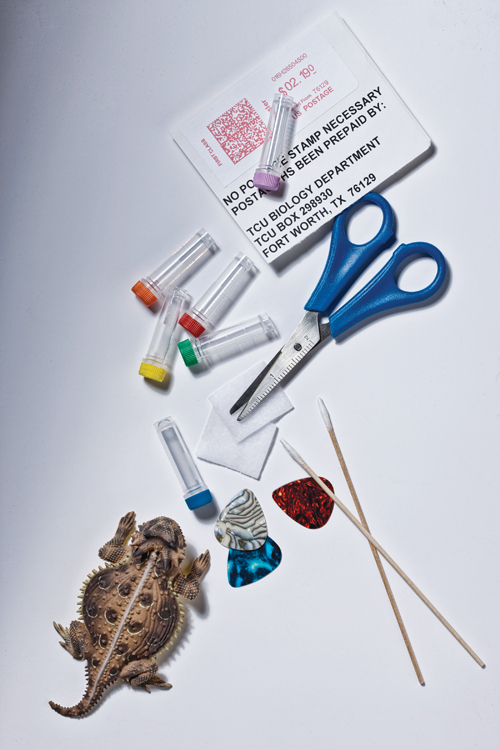Study Abroad | Business | Liberal Arts | Writing Center
| Science/Engineering | Briefs | Object Lesson

Save the frog!
TCU biologists track horned lizard
populations through DNA.

By Cathy Frisinger
Texas horned lizard, what ails thee?
Twenty years ago, the horned lizard, commonly known in these parts as the horned frog, was plentiful on the TCU campus. The human version still is, of course, but over the last two decades the reptilian namesake for the school mascot has almost completely disappeared from eastern Texas, including the TCU campus.
Biologists aren’t sure why, but possible reasons include habitat loss, collection for pet trade, climate change and, mostly likely, the invasion of fire ants, which both supplant the harvester ants that make up 70 percent of the horned lizard diet and prompt the heavy use of pesticides.
Whatever the reasons, the loss is heartbreaking to Texans in general and TCU partisans in particular.
If the reasons behind the demise of the horned lizard can be identified and conditions changed, perhaps the lizard can be successfully reintroduced.
Biology department faculty members Dean Williams and Amanda Hale think they might be able to contribute to that effort. Before joining the TCU faculty, the two assistant professors, who are partners off the job as well, had considerable experience with genetic analysis of birds in the jungles of Costa Rica.
"Once you know how to do DNA analysis, you can apply it to other living organisms," says Hale, who also did DNA analysis of plants during post-doctorate work at the University of Miami.
Hale and husband Williams applied for and receive a grant from the Texas Parks and Wildlife Department (the money coming, very appropriately, from those specialty license plates that feature an image of a horned lizard).
"We are using molecular methods to answer questions about conservation," explains Williams.
The project has three main areas of effort. First is delineating the population structure of horned lizards in Texas, identifying areas where the animal is still prevalent and pockets that remain in areas of decline. "If we can identify areas that are isolated, that might need special attention paid to them, then we might be able to help," says Williams.
The heart of the study is the genetic work. They are looking to identify 20 stretches of DNA that are not genes (areas that do not code for proteins) that can serve as markers. These non-gene areas of DNA, at one time referred to by scientists as "junk DNA," show changes when a given population is in decline, Williams explains. "You see a decrease in rare alleles and an increase in common alleles."
Undergraduate biology student Cory Leach has been helping Williams and Hale with this work, running horned lizard DNA samples through an electrophoresis machine that sorts components by size to help determine DNA structure. Hale says they are close to having this portion of the study complete, and to zeroing in on which markers they will be using.
The next step is analyzing DNA samples from horned lizard populations from around the state. Williams and Hale have enlisted the help of Texas Parks and Wildlife as well as a herd of volunteers in collecting the DNA samples. Volunteers are given a collection kit that includes swabs, guitar picks, alcohol wipes, rulers, collection sample tubes and instructions on how to collect DNA material from lizards without resorting to the traditional method of clipping off toes (hint: the guitar pick can be used to pry open the mouth).
The biologists will then look at the markers on the hundreds of collected DNA samples.
The information they gather from this analysis will tell them about the genetic dispersal of the animal across the state. Are horned frogs in the panhandle genetically different from horned frogs in Central Texas? If the animals in different regions are genetically different, that could explain differing survival rates, says Hale. If the animals are genetically the same across Texas, that will mean ecologists might be able to use animals from West Texas to repopulate East Texas, if biologists are able to correct the conditions that caused the decline.
A final component of the study is identifying the genetic type of the horned lizards at the Fort Worth Zoo. Animals bred in captivity in the zoo could potentially be used to repopulate areas where the animals have disappeared, Hale says, depending on how their genetic material compares with that of animals in the wild.
Williams and Hale may be Texas transplants -- both attended undergraduate school in the Midwest and they met in Florida -- but if their research helps with the re-establishment of the horned lizard in East Texas, they will have cemented their Texas -- and TCU -- bona fides.

To get a DNA collection kit, contact Amanda Hale
at a.hale@tcu.edu, or call 817.257.7165.
Comment about this story at tcumagazine@tcu.edu.
|



